In 2018, the volume of False Claims Act (FCA) litigation remained high, and health care-related qui tam (i.e., whistleblower) cases continued to lead the way. Using data compiled in the Mintz Health Care Qui Tam Database (which is described further below), this post analyzes the trends in cases unsealed in 2018. To evaluate long-term trends, we examined the annual Department of Justice (DOJ) compilation of FCA cases. Together these data sets show that health care cases continue to make up a large majority of all whistleblower cases brought under the FCA, and almost two-thirds of those cases were brought by current or former employees, mostly against large pharmaceutical companies, physicians, and hospitals.
Recent Trends Captured in the Mintz Health Care Qui Tam Databases
Mintz uses its Health Care Qui Tam Database to track activity in unsealed FCA cases to see what types of cases are being brought, who is being targeted, and who is bringing those cases. Here are some highlights from the twelve months ended November 30, 2018. We also report on qui tam case developments periodically through our Qui Tam Update.
Trend #1: Pharmaceutical Companies, Physicians, Hospitals, and Home Health Care Companies Were the Leading Targets of Unsealed Cases in 2018
The importance of drug therapies in modern health care is reflected in the high volume of FCA litigation against pharmaceutical companies. As shown in Table 1 below, pharmaceutical and biotech companies were, by a large margin, the most commonly targeted defendant type in FCA cases unsealed in 2018.
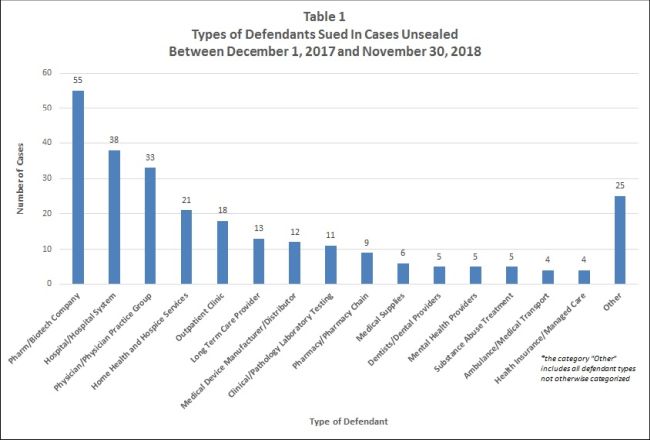
Source: Mintz Qui Tam Database
The cases unsealed against drug companies in 2018 typically focused on allegedly improper marketing practices, such as improper inducements offered or given to prescribers, as well as off-label marketing of prescription drugs. The volume of pharmaceutical-related litigation is presumably a function of the large volume of drug reimbursements under Medicare and Medicaid, which is arguably the case with respect to hospitals and physicians as well. The growing importance of home health and hospice care is reflected in the fact that, for a second year in a row, that sector ranked fourth in terms of the number of cases unsealed. Given the ongoing growth of the elderly population in the United States, such cases are likely to continue to constitute a leading category for unsealed FCA cases.
Trend #2: Government Intervention Rates Remain Low
Since 2012, when Mintz began tracking health care qui tam litigation, government intervention rates have consistently run at about 20%. As shown in Table 2, that trend continued in 2018.
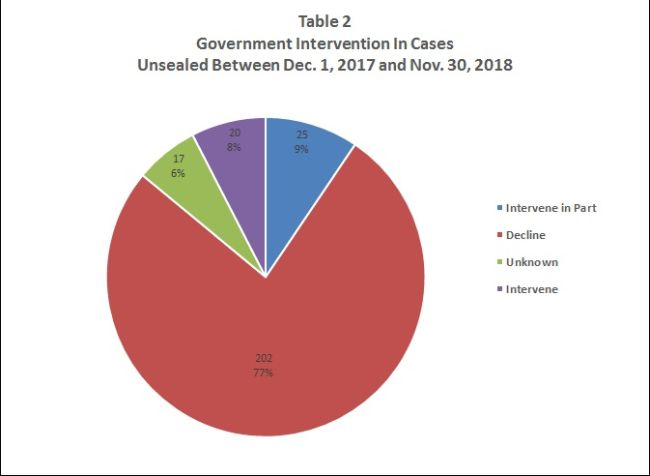
Source: Mintz Qui Tam Database
As this chart shows, the government outright declined 202 out of 264 unsealed cases, a declination rate of 77%. The government intervened in whole or in part in 45 of the 264 cases, an intervention rate of 17%. (The balance of the unsealed cases did not disclose the government's intervention decision). According to this data, the growing volume of health care related qui tam litigation has not increased the government's intervention rate.
Trend #3: Current and Former Employees are Most Common Whistleblowers
In cases unsealed in 2018, former employees were overwhelmingly the most common type of relator, as show in Table 3 below, making up almost half of all relators in the twelve months ended November 30, 2018.
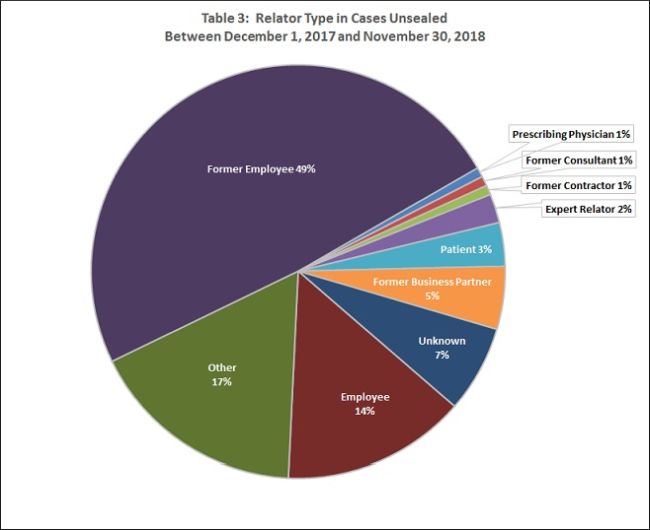
Source: Mintz Qui Tam Database
Together, current and former employees made up 63% of all relators during that period, continuing the trend that insiders remain the most common source of whistleblower cases. The number of contractors and consultants bringing qui tam cases has grown over time, but those categories remain quite small in comparison to current and former employees.
Long-Term Trends Captured in DOJ Data
Three years ago we published a piece examining qui tam litigation trends based on Department of Justice data. Armed with data for the ensuing years, including the recently released data for 2018, we continue to examine trends in this space. The following are some highlights from the most recent DOJ data.
Trend #4: Qui Tam Actions Continue to Dominate FCA cases, Especially in Health Care
In 2015, our analysis confirmed that the growth in FCA litigation over the preceding twenty years had predominantly been due to cases brought by private parties (i.e., whistleblowers) rather than the government. This trend has continued in the intervening years. The charts below demonstrate that the total number of FCA cases is driven largely by the number of qui tam cases. For example, as Table 4 illustrates, the volume of government-instituted cases has remained largely unchanged since the late 1990s while the volume of qui tam cases has skyrocketed, leading to overall growth in FCA litigation.
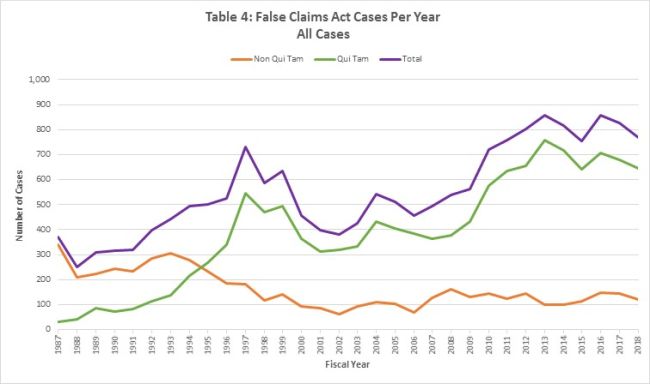
Source: DOJ FCA Data for FY2018
That same trend is illustrated in bar chart form in Table 5, which shows that as the overall number of cases continues to climb, the growth consists almost entirely of whistleblower cases.
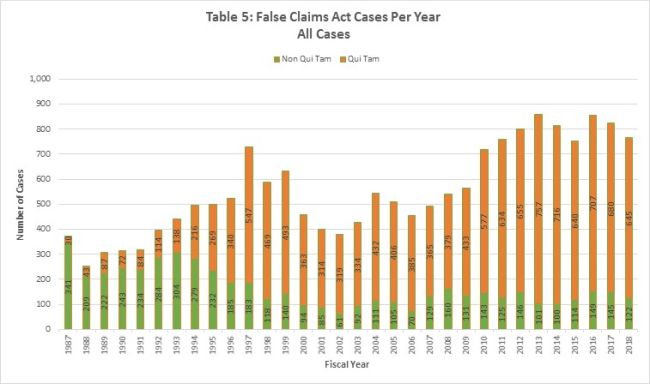
Source: DOJ FCA Data for FY2018
The data also illustrate that health care-related cases (categorized by the DOJ as "HHS cases") continue to dominate FCA cases. Just as qui tam litigation growth has driven increases in overall FCA litigation, the data in Table 6 show that growth in health care-related cases has fueled that trend.
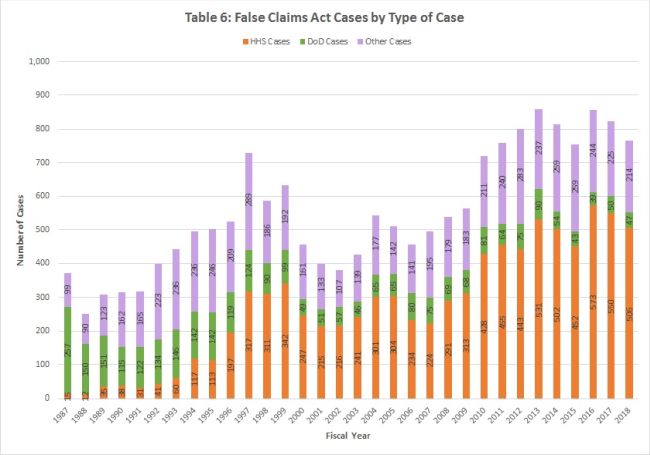
Source: DOJ FCA Data for FY2018
And, as we found with FCA cases overall, the vast majority of HHS cases continue to be brought by private individuals. As shown in Table 7, over each of the past twenty years, the percentage of health care-related FCA cases instituted as privately filed qui tam cases has ranged between seventy-nine and ninety-five percent.
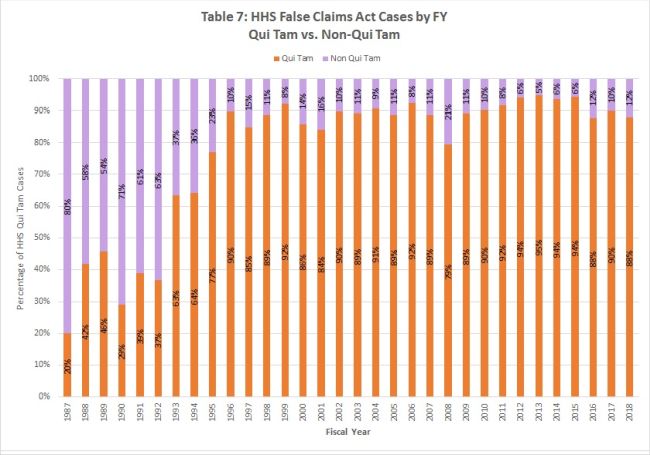
Source: DOJ FCA Data for FY2018
Trend #5: Total Settlements and Judgments Decline, but Health Care Recoveries Trend Upward
Since 2014, we have seen a decline in the total dollars recovered under the FCA. As shown in Table 8, total recoveries have fallen from a high of $6.1 billion in 2014 to $2.8 billion in 2018, the smallest annual recovery since the $2.5 billion recovered in 2009.
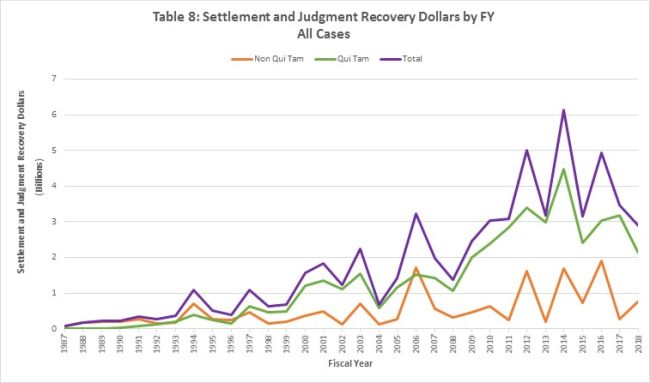
Source: DOJ FCA Data for FY2018
This drop in total recoveries appears to be due mostly to a 88% drop in the number of "Other" FCA cases over the last three years (i.e., cases that fall outside of the HHS and DoD categories), as illustrated in Table 9.
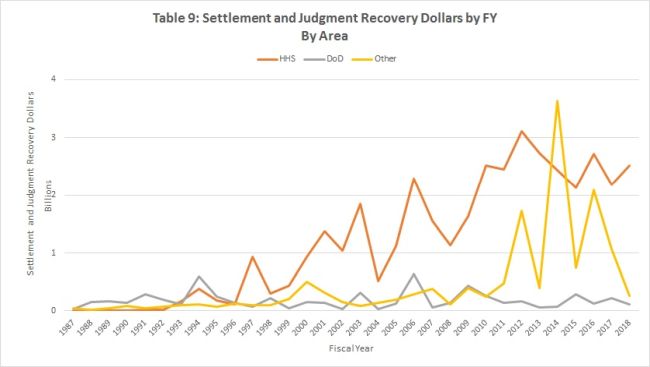
Source: DOJ FCA Data for FY2018
While health care-related recoveries appear to have ticked upward in 2018, that increase may be due, in part, to the government's creative accounting, in which it included in the FY 2018 figures two large settlements announced on October 1, 2018, which is technically in FY 2019.
Table 10 illustrates that, with the exception of 2006, the last twenty years have seen qui tam cases drive the recovered dollars.
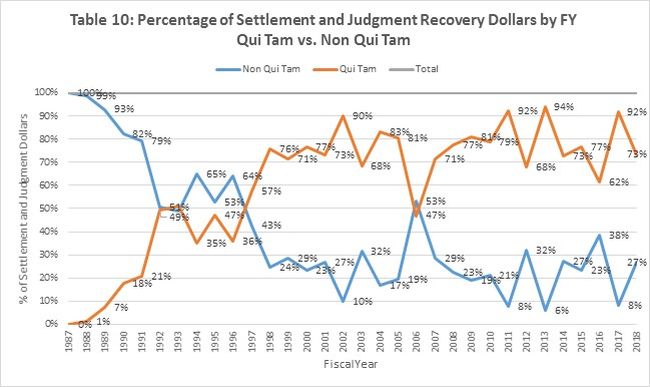
Source: DOJ FCA Data for FY2018
Given the preponderance of qui tam lawsuits in overall FCA litigation, this trend will presumably continue beyond 2018.
Our Health Care Enforcement Defense team is blogging on its annual review of key government policies, case law developments, and enforcement actions in 2018, and the impact these trends are expected to have on enforcement in the year ahead. Our series will continue tomorrow with an examination of criminal enforcement trends. Stay tuned for the rest of our series and an invitation to our annual webinar, Health Care Enforcement Review & 2019 Outlook, on January 30, 2019.
The content of this article is intended to provide a general guide to the subject matter. Specialist advice should be sought about your specific circumstances.


